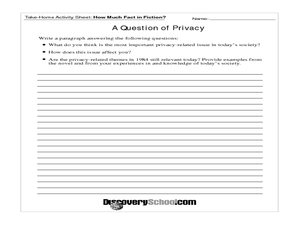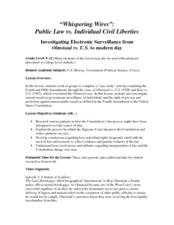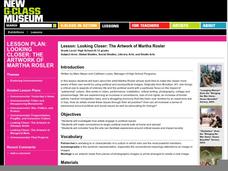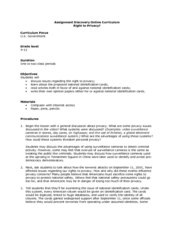Curated OER
Privacy in the Age of Video Surveillance: This Is Not Your Father's Candid Camera
Eighth graders examine the use of video surveillance in the corporate world and other life situations. In groups, they determine how many times and in what situations they believe they are being watched. They use the Constitution to...
Deliberating in a Democracy
Surveillance
Big Brother is always watching you! Scholars analyze the impact security cameras have on the legal system in a democracy. Primary documentation, case studies, and video clips investigate the use of video in prosecution and provide an...
The New York Times
Where to Draw the Line: Balancing Government Surveillance with the Fourth Amendment
The question of how to balance Fourth Amendment Rights with national security concerns becomes critical in an age of planned terrorist attacks, election interference, and fake news. Get young social scientists involved in the debate with...
Curated OER
1984: How Much Fact in Fiction?
Students compare and contrast the society in Orwell's 1984 with modern society. In this 1984 lesson, students research the historical climate in which Orwell wrote the novel. Students create a comparison chart of privacy issues in the...
The New York Times
Big Brother vs. Little Brother: Updating Orwell's 1984
Government surveillance is an enduring conflict that has become increasingly complex with our nation's use of technology. Add to the understanding of Orwell’s 1984 by using the resources here that display the contemporary actions of Big...
Curated OER
Watch Yourself
Students consider the benefits of CCTV. For this current events lesson, students research the listed Web sites that include information about European efforts to curb antisocial behavior through surveillance. Students discuss the...
Curated OER
"Whispering Wires": Public Law vs. Individual Civil Liberties
High school student love discussing controversial issues like those brought up in this fourth amendment case study. They examine the 1928 Olmstead vs. U.S. prohibition court case, applying the fourth amendment to determine whether...
Curated OER
Right To Privacy?
High schoolers examine privacy issues. In this global issues lesson, students discuss privacy issues, surveillance cameras, and national identification cards. High schoolers conduct further research about the pros and cons related to...
Curated OER
Lesson: Looking Closer: The Artwork of Martha Rosler
Have a class discussion to better understand the art of Martha Rosler. Young art critics consider Martha's art as it is used to express issues of political unrest and social awareness. They look at each of the five images and use the...
Curated OER
Assignment Discovery Online Curriculum Right to Privacy?
Students explore privacy rights. In this civics lesson plan, students investigate the pros and cons of proposed national identification cards as they explore provided Internet links. Students write position papers pertaining to the...
C-SPAN
C Span Classroom: Teaching About National Security and Surveillance
Learning module and lesson plan which examines whether or not the federal government should monitor phone and internet activity to protect the security of the United States. Comprehensive materials including C-SPAN videos and related...
PBS
Pbs Learning Media: Pov's 32nd Season Collection
POV's 32nd season highlights stories from women's perspectives on issues ranging from youth-led climate activism, domestic surveillance, rape culture, historical trauma, industrialized agriclture and others, with nine films showcasing...
University of Minnesota
Univerity of Minnesota: Global Rem: Border Control & Technology
This resource uses articles, images, and videos that describe the use of sophisticated technologies to control migration at the border between the United States and Mexico. The goal is to encourage students to understand how technology...











